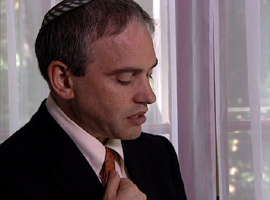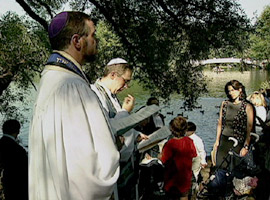In This Episode << SLIDE LEFT TO SEE ADDITIONAL SEGMENTS
Sin and Repentance
BOB ABERNETHY, anchor: Muslims this week (September 30) mark the end of the holy month of Ramadan with the festive Eid al Fitr, and the Jewish High Holidays begin Monday evening (September 29) with Rosh Hoshana and end 10 days later with Yom Kippur (October 9).
Our Belief and Practice segment today centers on the High Holiday concepts of sin, repentance, and forgiveness, as explained by Rabbi Dan Ehrenkrantz, president of the Reconstructionist Rabbinical College in Philadelphia.
Rabbi DAN EHRENKRANTZ (President, Reconstructionist Rabbinical College, Philadelphia, PA): This process of repentance is central to my religious life.
 When I recite the al Cheyt prayer I may be reciting a litany of sins, some of which are my very own, but some of which are not mine. Yet we say the prayers in the plural because we understand if these things have occurred within our community, in some ways we are responsible.
When I recite the al Cheyt prayer I may be reciting a litany of sins, some of which are my very own, but some of which are not mine. Yet we say the prayers in the plural because we understand if these things have occurred within our community, in some ways we are responsible.
The most common Hebrew name for sin is Cheyt. Cheyt means something akin to going astray. It’s actually a term that is used in archery. So if you can imagine an arrow which is being shot from a bow that is directed towards a bull’s eye that is the trajectory of our lives.
Rabbi DEBORAH WAXMAN (Vice President, Reconstructionist Rabbinical College, singing prayer): And for the wrong we have done before you through an evil inclination.
Rabbi EHRENKRANTZ: The steps of teshuvah, of repentance, would involve understanding how you had hurt someone and then approaching that person for forgiveness.
Once forgiveness has been achieved between the people, repentance then needs to include asking God for forgiveness as well. To ask for forgiveness takes a level of humility to be able to say I have done wrong and then to say it out loud. It’s not enough that I realize I have done wrong; I have to say it out loud to you. I have to tell you what I did, and that is a very difficult thing for us to do. But when we remake ourselves, we truly do look back and say how could I have done such a thing?
 Tashlich is a ceremony in which Jews will traditionally join together and cast breadcrumbs from their pockets, as it were, to symbolize the sins. The idea is that we are casting our sins out.
Tashlich is a ceremony in which Jews will traditionally join together and cast breadcrumbs from their pockets, as it were, to symbolize the sins. The idea is that we are casting our sins out.
There is in Judaism no idea of original sin. Rather there is, I would say, an understanding that we as human beings are in a challenging situation. We make mistakes. We err, and it is then our responsibility to learn from our mistakes and to become better people from our mistakes.
You can be sinful in thought. Some Jews actually don’t think that that is covered, but it is. They think that it is only actions but thoughts, too, can be sinful.
Yom Kippur divides sins into sins that we have done intentionally and sins that we have done unintentionally. Most of us don’t know many of the sins we have committed over the course of the year, and yet we carry around a general sense that we haven’t always done the right thing, and so being able to purge that sense of guilt that we walk around with as a condition of being human is a great blessing.
The true mark of repentance is, have you made yourself into a different person? And if you have truly made yourself into a different person, then absolutely God forgives.

